Keyer Paddles
Vibroplex Paddle | Autotronic Paddle
BTL

Vibroplex Paddle | Autotronic Paddle

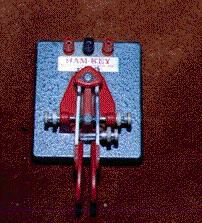
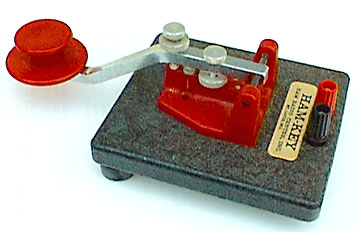
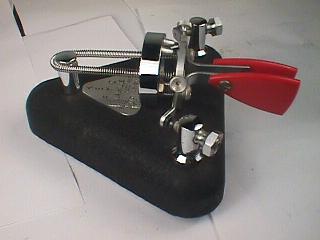
William Nye was born in North Dakota in 1912 and moved to the Seattle area in 1924. He has been an amateur radio operator (W7DZ) since age 12. He owned a business machine company until he sold it and retired in 1971. He established the William M. Nye Company as a retirement business.
The Nye company bought the SPEED-X trademark from the E.F. Johnson Company in the fall of 1972. The Nye company bought tooling to manufacture keys, low pass filters, matchboxes, and sounders. Bill Jr. does not believe that they bought the tooling to manufacture bugs.
Nye's present line of keys are manufactured on site, though casting, painting, and some machine functions are contracted out. Small parts are manufactured on site using a variety of stamping and drilling machines. Many of these machines have been modified by Bill Jr. to power them with air or hydraulic pressure. He is an inveterate tinkerer, and does most of the manufacture of small parts himself. Screws are bought from vendors, and key assembly is done by a part time employee.
Nye is using the same key casting molds that were used by the Les Logan and E.F. Johnson Companies. These molds were re-worked in 1972 by a machine shop. This involved polishing, milling, and filling them. These molds were acquired from the Johnson company, and it is doubtful that new ones have been made since the 1930's. Their key bases are cast in Zinc by a sub-contractor in the Seattle area. Zinc is used because of ease of casting, low cost, and solid weight. Information gathered from the N7CFO KEYLETTER'S, Story by Lynn A. Burlingame N7CFO
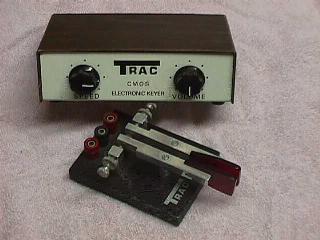
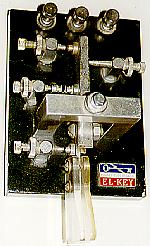
The El-Key is a heavy non-iambic set of paddles that were manufactured in
the late ' 50s and early ' 60s by Bob Poucel W2AYJ -- "Poucel
Electronics Co.". The bases were delivered to Bob [Poucel] completely
finished, plated and ready for assembly. The other component parts were
also manufactured out of house, and all that Bob had to do was assemble
and adjust the keys. The name El-Key was short for Electronic Keyer.
Approximately 400 were made between the years 1956-1960. The design was
based on a homebrewed set of paddles...They were available in
black,gray and Chrome.
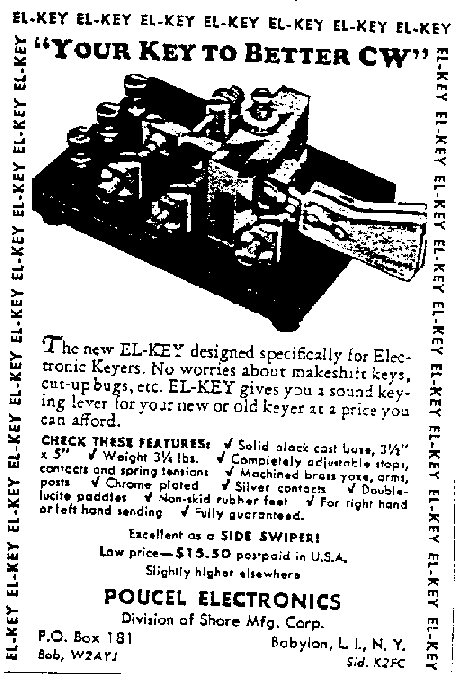
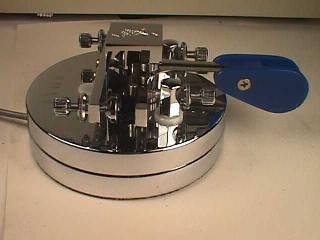
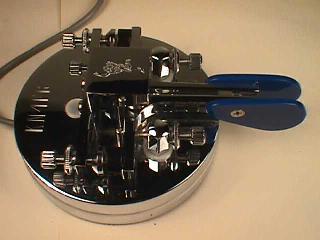
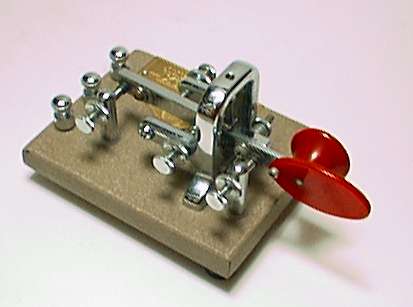
Produced: 1960 - present
Patents: None
Plate types: D6-D9
Base colors: Beige, chrome, gray crackle, gold, black texture.
Variants: Beige "Deluxe" model; nameplate orientation.
Harry Beecher introduced the first fully automatic electronic keyer in his April 1940 QST article, "Electronic Keying." Operating this device required a new type of mechanical key. Beecher recommended: "The switching arrangement is an ordinary bug with the bar connecting the dash and dot terminals removed and the proper wires installed. The dot contact is, of course, rendered non-vibrating."
After the end of World War II , electronic keyers began to be manufactured in large numbers for both the amateur and commercial radio operators. Neither mutilated bugs nor jack-switches proved to be the ideal solution for actuating these keyers. Keyer paddles specifically designed for the new electronic keyers started appearing on the market. Vibroplex finally joined the electronic revolution by offering the "Vibro-Keyer" in 1960 . (The spelling was changed to "Vibrokeyer" in the early 1980's) The frame, pivots, lever and contacts of this single-lever paddle all came from the Orginal. A small phillips-head screw filled the tapped hole in the left arm where the bug's dot lever stop screw would have gone.
The new paddle arrived with great confusion. The 1960 ARRL Handbook introduced Vibroplex's entry into this market the Vibro-Keyer, with a beige crackle finish. In its February 1960 review, QST mentioned that the base had a "wrinkle gray" finish, like the standard bugs at that time. In fact, it appeared with a beige finish. At the same time, Harrison Radio offered the Vibrokeyer with a "special gray finish" to match the Hallicrafters TO keyer the company was promoting. Then there were the red fingerpieces, "the Deluxe Vibroplex contacts, main frame and super finished parts", and the red plastic button atop the frame. Was this a Standard or a Deluxe paddle? A real Deluxe Vibrokeyer, with a chrome plated base, appeared in the spring of 1961. At the same time, the beige-based model became the Standard model. In the early 1980's , after the Company had been sold and moved to Maine, the Standard model base color was changed to gray to conform to the rest of the line. Today, the Vibrokeyer made in Alabama comes in three models: The "Gold," with a 24K plated base and jewel bearings, the "Deluxe," with a chrome-plated base and jewel bearings, and the "Standard," with a "crisp textured finish black base" Vibrokeyer offered three variations nameplates. At first, the plate was mounted transversely, and faced to the rear, away from the operator. Shortly thereafter, it was turned to face the right side. Today, the plate on the Alabama Vibrokeyer faces the operator. The paddle's shown are beige Serial number 267879 --- 833 Broadway New York --- Information compiled from various sources including The Vibroplex Co. INC. by William R. Holly K1BH and The Vibroplex collector's guide by Tom french W1IMQ
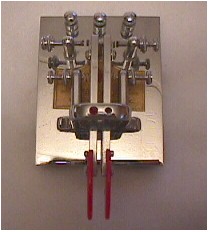
In 1978, Peter Garsoe bought Vibroplex from Vinnie La Hiff, packed up all the machinery, stock, and the meager records, and moved the whole lot to Portland, Maine, where he had several other business interests including a small hand tool manufacturing company. The tool company used similar technology to the Vibroplex Keys, and Garsoe, rightfully as it turned out, assumed that the two companies would be able to share facilities and operat ing personnel at a savings in costs to both. Garsoe had all the old machinery refurbished and old dies rebuilt or replaced. He then streamlined the product line to meet current market conditions. The Lightning Bug and Champion were dropped,several changes in the key lineup were made. The most noticeable was the addition of a new member of the family: the Iambic, which was similar in style to the Vibro Keyer. The Iambic is, as the name states, a dual lever electronic keyer paddle. It used the cast Original bug frame, and the early ads show a small phillips screw plugging the tapped hole in the left arm intended for the bug's main lever return spring adjustment screw. But most, if not all, of the units actually shipped had frames drilled specially for the Iambic, without the extra hole. In contrast to the introduction of the VibroKeyer, there was no confusion with the Iambic. From the start, it was offered either as a Standard model with a gray crackle-painted base, or as a Deluxe model with chromed base. About 1983 , a third model, the Iambic Presentation, was introduced. Like the Presentation model of the bug, this was the Deluxe model with a gold plated brass plate on the base. With the addition of the "Presentation Gold" from Alabama in 1995 , the Iambic is now available in four models. This latest model does away with the brass plate; the steel base itself is gold plated. Today, the Standard model has the latest "crisp black textured finish" used on the Standard model bug and Vibrokeyer. This unit is Serial number 4430 ----Information was compiled from various sources including The Vibroplex Co., INC. by William R. Holly K1BH and The Vibroplex collector's guide by Tom French W1IMQ
Interest in electronic keying among radio amateurs grew quickly after WWII, and it soon became clear that the keyer/paddle system would eventually predominate. By the late 1950's stand-alone paddles (as opposed to paddles incorporated into keyers} were being offered commercially. In 1960 , the Electrophysics Corporation, a California manufacturer of marine electronics located in Newport Beach, came out with a paddle it called the "Autronic." The price was $16.95
The Autoronic was designed by John Jay Jakosky, W6QJR, and his son, John, Jr, K6ONJ. The senior Jakosky had been a railroad telegraph operator years earlier, and had held a two-letter ham call before the war.
Paddles preceding the Autronic, wether commercial or home-brew, were simple in design and construction. They were of the single-lever type. Most of them were made like a sideswiper with electrically separated left and right contacts. Many homebrew creations were cut-down bugs [like the Vibroplex Zephyr!] or used a hacksaw blade for the lever. Jakosky's design involved a cast base, a "pivoted bifurcated yoke" that moved either with or independently of the main lever, and unusually long paddles on the lever. In June 1961 the Jakoskys applied for a patent on the key; patent no. 3,098,898 was issued on July 23 1963.
The entire Jakosky family participated in the manufacture of the Autronic. During summer vacation from high school, John Jr's son (John III) assembled paddles. Electrophysics also offered a transistorized Autronic Keyer for use with the paddle. It had speed, weight and mode (automatic or semiautomatic) controls and a built-in sidetone monitor with speaker. Since the principal products of the company were marine oriented, it promoted the appropriateness of its Autronic key and keyer for shipboard use, even in its advertising to hams In QST and 73 Magazine.
The underbase of the Autronic shown identifies its maker with the cast-in legend "Electrophysics Corporation / Newport Beach, Calif. " in small letters. In 1965 the company moved to Costa Mesa. The last ads for the Autronic paddle, at $19.95, appeared in 1968. There sales were limited. Soon after, the company sold off some of its product lines, including the key, but manufacture of the Autronic was not continued by the purchaser.
( Collected from bits and pieces from " N7CFO Keyletters 1992-1997) , ---- " TVC W1IMQ the Vail Correspondent 1992-1997 " --- N6TT the Telegraph-Wireless World , who bought a new set in 1966 and used them for 20 years.
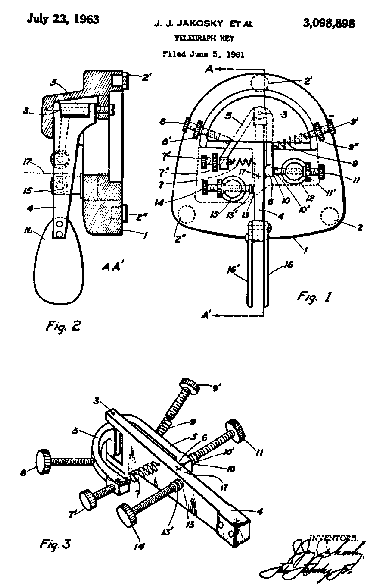
|

|